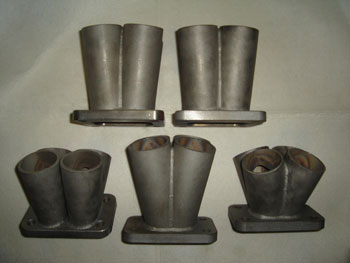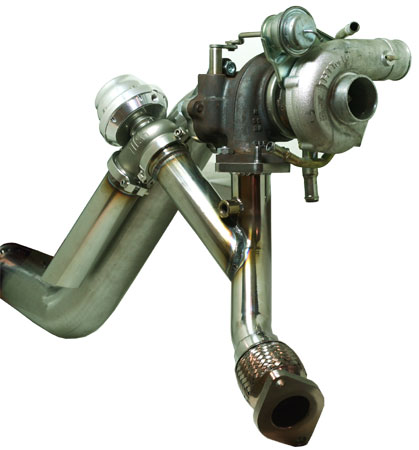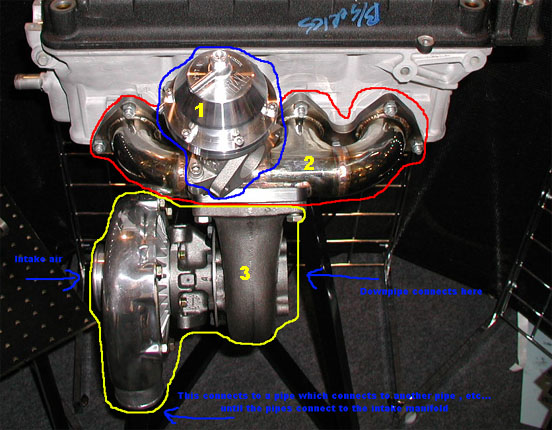| What's Hot! | Products/ Tools | EFI Tuning | Basic Tuning | Advanced Tuning | Chassis Tuning | Advertise with us |
Turbo Manifold Designs
A look at log, tubular, and twin-scroll manifolds.
Contributed by: Enginebasics.com
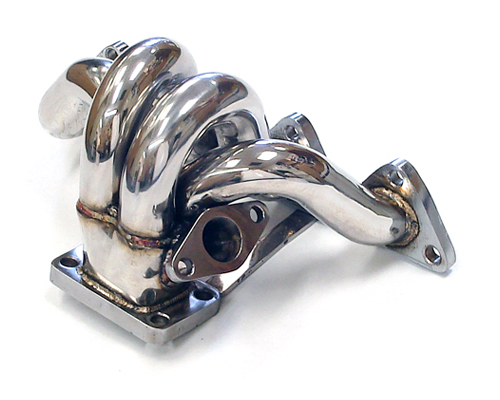
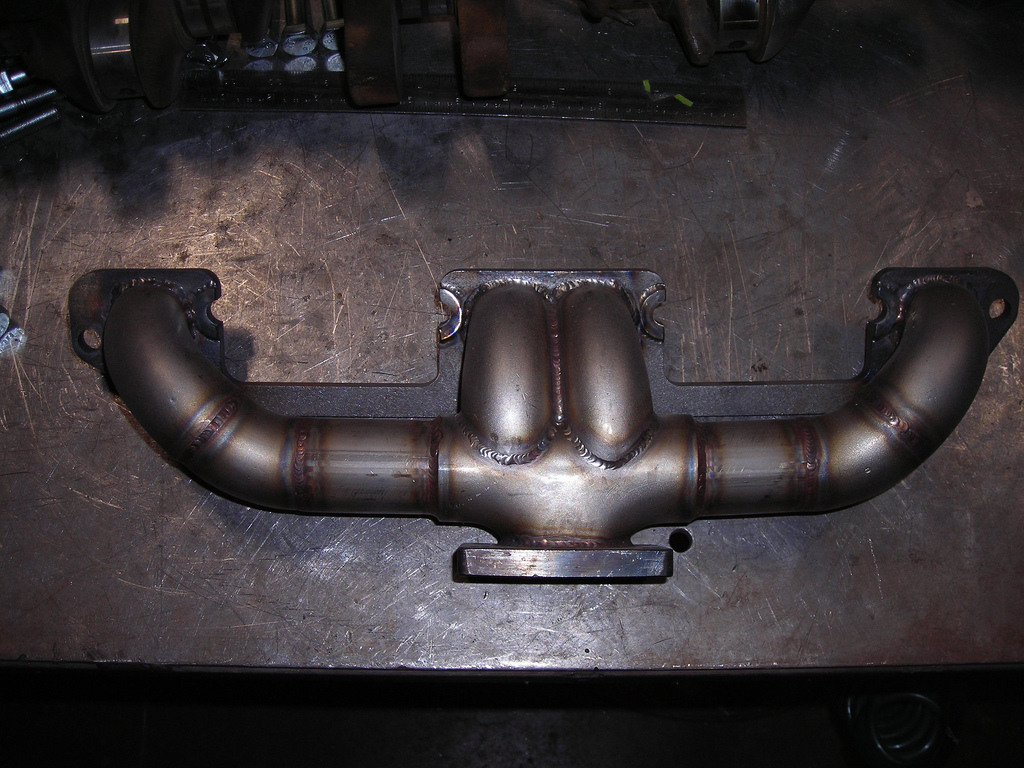
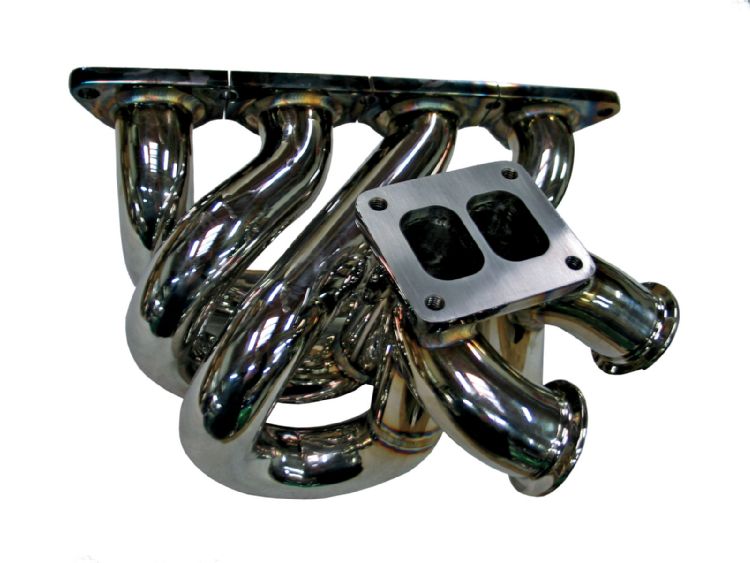
When it comes to turbo manifold design there is actually a lot more to it then just connecting all of the exhaust ports together to feed the turbo. The reality is there is a lot more physics at play. The exhaust flow, pressure, and runner length are all very important in deciding the many characteristics that make up a turbocharged car. Hopefully this article will be able to give you the basics to understanding what is involved with the designs of different turbo manifolds.
Basics of Turbo Manifolds
The idea behind a turbo manifold is to collect all of the exhaust gases from the motor to a common turbo flange where the turbo may be bolted. The following are the basics that can be changed to control the characteristics of a given manifold.
1. Runner volume based on runner pipe/tube size. 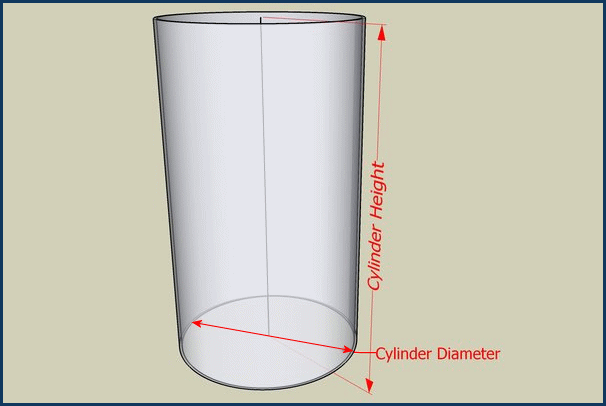
2. Collector angle towards turbo flange
4. Wastegate placement
1. Runner Volume
Runner volume needs to be considered when building a turbo manifold. While a larger runner diameter does facilitate lower exhaust backpressure for better flow on the top-end, it does cause a lower exhaust velocity. A lower exhaust velocity will cause longer spool times, and less transient response out of the turbo.
2. Collector Angle
The collector angle is important in dialing in how the exhaust gasses will come together and merge before the turbo. The less the angle the better the flow, but often times the space you have to work with will dictate the collector design. While a proper collector is important, it is not as important as the individual runners design, so better to give up some angle on the collector if it gives you an advantage on the runner design.
3. Runner Length
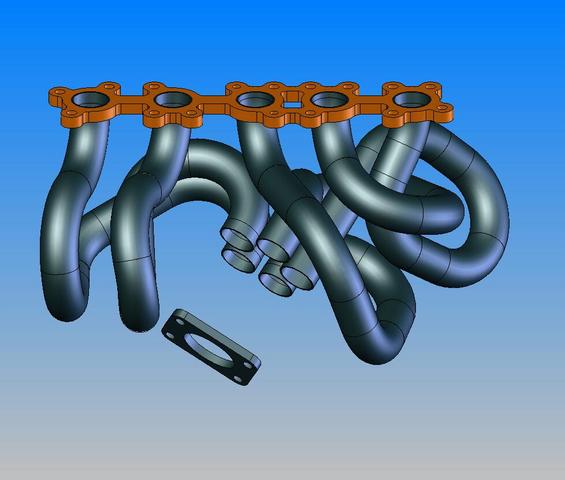
This is arguably one of the most important factors. First would be to make sure that the runners are as equal length as possible. The idea being that the exhaust pulses will be spaced out evenly and arriving at the turbine wheel on the turbo at there own time in the firing order. If they arrive sooner or later, they may interfere with the exhaust pulses from the next firing cylinder. Next, a longer runner manifold will have better flow up top, while a shorter manifold can yield a faster spool, with also less transient lag. This is only a small description. The importance of runner length has been fully discused in the article called: Short vs Long runner length exhaust manifolds.
4. Wastegate Placement
The wastegate should be placed in a location where it can be fed by all of the exhaust runners. It also needs to be able to receive good flow from the runners. The idea behind this is that the better the wastegate can flow, the better it can control boost and keep you from getting spikes or over boosting.
Common Types of Turbo Manifolds
There are two main types of turbo manifolds with many renditions of each of them.
1. Log Manifold
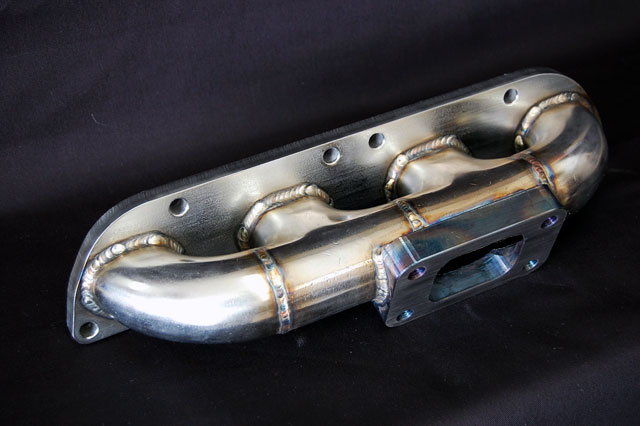
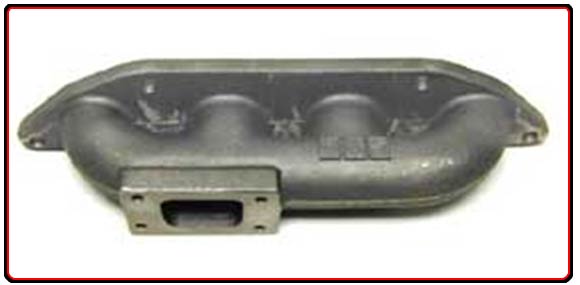
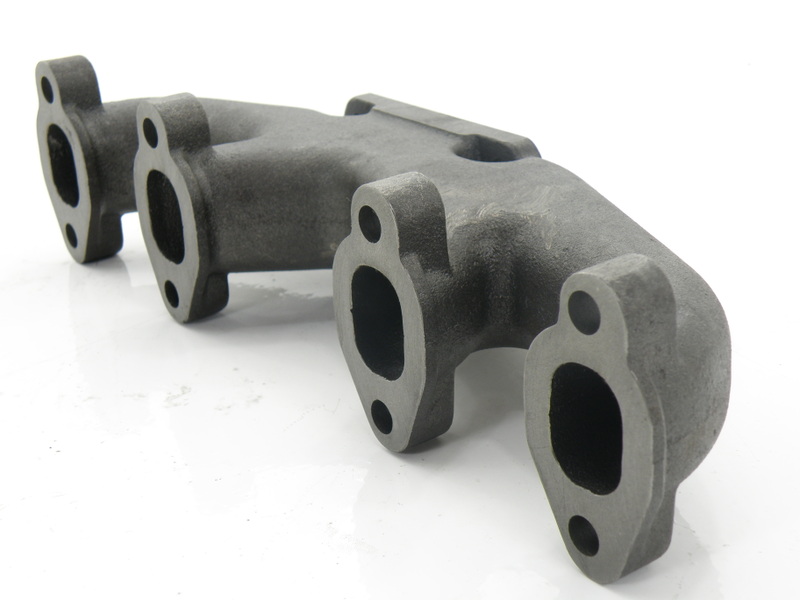
The log type manifold is the most economical manifold on the market. They are almost bullet proof when it comes to reliability and they are the most compact manifolds available. Most manifolds you find on factory turbocharged cars are log type manifolds. This is understandable when you figure a manufacturer is all about reliability. When it comes to performance, a log manifold will leave you wanting. All of the exhaust gases flow into a common plenum where they often collide with each other causing a lot of turbulence before the turbo. This hurts the turbo’s performance and hurts the motors performance as well being that a log manifolds common plenum is so close to the other cylinders, it causes a lot of back flow of exhaust.
2. Tubular Manifold

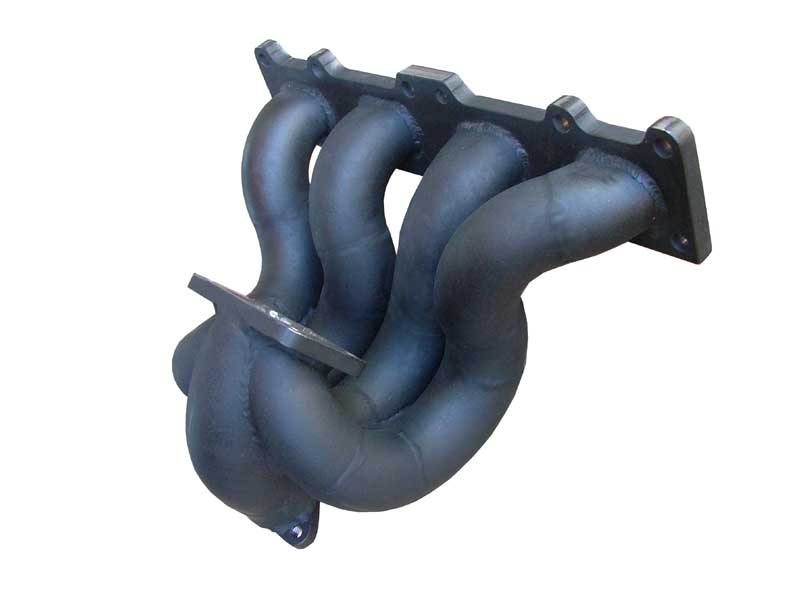
A tubular manifold is one that is custom made for that particular users goal for the car. Most road racing cars will build an avg. runner, equal length manifold that will support great flow characteristics throughout the entire rev range. A car being set-up for drag racing will use a long runner tubular manifold, which will favor flow in the upper rev range. Tubular manifolds are VERY efficient when compared to a log manifold. They offer superior flow characteristics, and offer less back flow of exhaust gases back into the motor. Now for the negative……tubular manifolds are often prone to cracking causing them to lose points in the reliability column. For those focused on getting the most performance they can, a tubular manifold is a must.
a. Single scroll Manifold
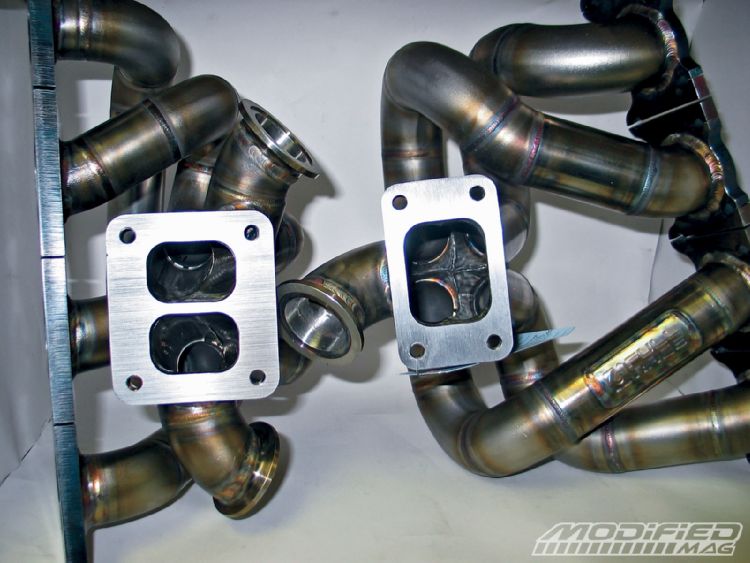 single scroll on right, twin scroll on left.
single scroll on right, twin scroll on left.
A single scroll manifold is one where all the exhaust runners come to a common collector where they enter the turbocharger. Also all the runners share a common wastegate to expel exhaust gases. This is the most common type of tubular manifold.
b. Twin Scroll or divided Manifold

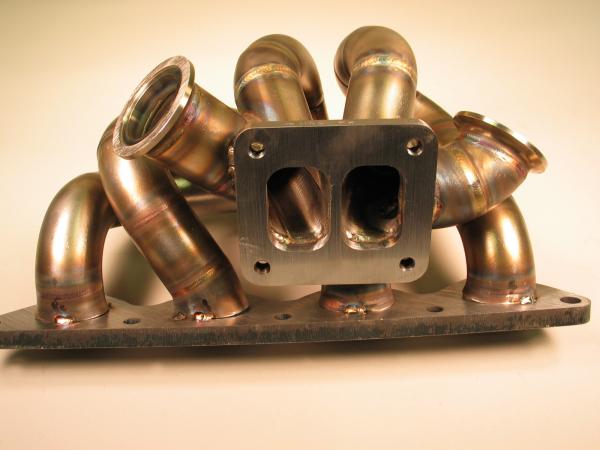
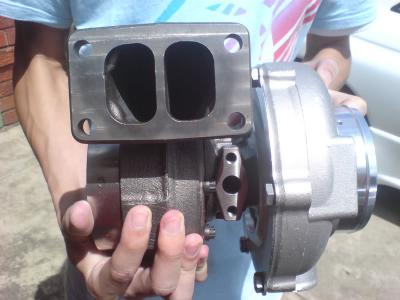
A twin scroll manifold is designed for the most ideal exhaust flow a motor can offer. These manifolds are built so that runners that come together are paired to be 180 degrees apart from each other on their firing order. This is done so that there is little chance of exhaust flow interference from another cylinders exhaust gases. This not only helps the motor to better expel its exhaust, but also helps to keep the exhaust velocity as high as possible, aiding in the turbochargers spool and the motors torque output. A twin scroll manifold must be used with a turbo that is equipped with a twin scroll housing that keeps the exhausts divided all the way to the turbo’s exhaust wheel. To truly do this, separate wastegates should be used as well as keeping each side fully divided. While this might be one of the best flowing set-ups when it comes to turbo manifolds, it is also the most expensive. While the gains are noticeable, a well-built single scroll tubular manifold can perform almost as well. One should weigh the costs before deciding whether to go with a single or twin scroll manifold.
As you can see there is a lot more to a turbo manifold than meets the eye. This is only just the basics of turbo manifolds. There is a lot of physics that goes into designing the perfect manifold, but hopefully this article has given you the basics you need to understand the pro’s and con’s of each manifold and which manifold would be best for you. If you have any comments or questions be sure to contact us.
For information and a how to on building your own turbo manifold, follow the link below:
How to build your own turbo manifold
ATTENTION READER:
If you enjoyed the information and article you just read be sure to check out our newly released book with even more exciting photo's and information:How to Turbocharge and Tune your Engine

Want to know more about your particular Make and Model vehicle? All of these vehicles are covered in the tech, maintenance and repair articles found above. Enginebasics is the wiki or wikipedia of car part, repair, how to and tuning information. Let us be the class 101 for your automotive learning.
| Ford | General Motors GM | Pontiac | Jaguar | Land Rover | Nissan |
| Toyota | Honda | Lexus | Acura | Lotus | Scion |
| Infinity | BMW | Mercedes | Mitsubishi | Ferrari | Maserati |
| Lamborghini | Volks Wagen VW | Saab | Audi | Hyundai | Kia |
| Subaru | Mazda | Chevy | Volvo | Caddilac | Dodge |
| Chrylser | Daewoo | Porsche | Mercury | Freightliner | MG |
Individual Models
| Ford Mustang | Mitsubishi Eclipse | Mitsubishi Evo | Subaru WRX / STI | Dodge Viper | Chevrolet Corvette |
| Nissan Skyline | Honda S2000 | Nissan 350z | Toyota Supra | Chevy Camaro | Lotus Elise Exige |
| Honda Civic | VW Golf | Dodge SRT-4 | Eagle Talon | Acura Integra | BMW M3 |
| Nissan 240sx | Porsche 911 | Acura NSX | Honda Accord | Toyota Camry | Toyota MR2 |
| VW R32 | Dodge Truck | Mazda Rx7 | VW Jetta | Sand Buggy | Nissan Sentra |
For the latest Automotive news and stories visit the websites below |
Our feature Build: An AWD V6 Civic



